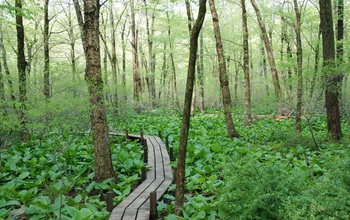Hola amigos: A VUELO DE UN QUINDE EL BLOG., hemos recibido información de la Fundación Nacional de Ciencia de Los Estados Unidos, sobre la investigación de los ecosistemas en el estado de Massachusetts, se comprueba que todas las tierras que no son iguales. Algunos ecosistemas hacen triple deber de los beneficios que aportan la sociedad. Bosques de Massachusetts, por ejemplo, filtrar el agua potable pública, son el hábitat de especies amenazadas y almacenar carbono para combatir el cambio climático..........
More information....
Researchers call hotspots valuable, but say their growing numbers might be cause for concern Credit and Larger Version |
May 14, 2015
The following is part 18 in a series on the National Science Foundation's Long-Term Ecological Research (LTER) Network. Visit parts one,two, three, four, five, six, seven, eight, nine, 10, 11, 12,13, 14, 15, 16 and 17.
All land is not created equal. Some ecosystems do triple-duty in the benefits they provide society.
Massachusetts forests, for example, filter public drinking water, provide habitat for threatened species and store carbon to combat climate change.
Hotspots: hardest-working ecosystems
Ecologists single out the hardest-working ecosystems--called "hotspots"--for their exceptional value.
Results of a study published this week in the Journal of Applied Ecology show that the number of hotspots has increased in Massachusetts over the past decade, with more and more popping up in metro Boston.
But, the authors of the paper say, more hotspots may not be a good thing.
Jonathan Thompson, an ecologist at the National Science Foundation's (NSF) Harvard Forest Long-Term Ecological Research (LTER) site and co-author of the paper, says that the increasing number of hotspots signals a degradation of other ecosystems across the state.
"Over the past 10 years, urban development has increased by more than 6 percent, at the expense of forests and agricultural lands," Thompson says.
"When we lose intact forests, we lose stable flows of clean water, climate regulation, recreational opportunities and wildlife habitat. The remaining forest is left to pick up the slack."
The result is more hotspots that do the work of larger forests.
Emerging ecosystems
Meghan Blumstein of Harvard University, lead author of the paper, notes that hotspots are valuable and worth saving.
But, she adds, "an increase in their number reflects an ongoing division of the natural landscape into smaller units, which are expected to produce the same number of services with less."
Saran Twombly, lead program director for the NSF LTER program--which funded the research through NSF's Division of Environmental Biology--says that the study takes a broad view to show that exploitation of land affects a wide range of services we expect the natural environment to provide.
"Humans have used the land for millennia to satisfy particular needs," Twombly says.
Satellite mapping
Using satellite maps, the team tracked changes in land cover, such as forest clearing for agriculture or development, across Massachusetts from 2001 to 2011.
In each 30-meter square on the map grid (about the size of two basketball courts), the scientists used computer models to assess which benefits each ecosystem could provide and how those benefits changed over time.
The researchers found that some benefits, such as providing habitats for wildlife, declined state-wide over the study period.
But other benefits, including carbon sequestration and outdoor recreation, increased. Intact forests are growing rapidly and more land is being conserved.
Study scale important
For some benefits, the scale of the analysis made a big difference, Blumstein says.
When analyzed at a local scale, an area of forest in the state's Quabbin Reservoir may look less like a hotspot than it does a local park.
But when examined at a regional scale, the continuous forest area around the Quabbin Reservoir provides clean drinking water for millions of Massachusetts residents.
"The sustained delivery of benefits from nature requires an approach that considers conservation at multiple scales," Blumstein says.
In other words, the researchers say, we need to be able to see the forest, not just the trees.
| -- | Cheryl Dybas, NSF (703) 292-7734 cdybas@nsf.gov |
| -- | Clarisse Hart, NSF Harvard Forest LTER Site (986) 756-6157 hart3@fas.harvard.edu |
Investigators David Foster
Related Institutions/Organizations Harvard University
Related Awards #1237491 LTER V: New Science, Synthesis, Scholarship, and Strategic Vision for Society
Total Grants $2,940,003
Related WebsitesNSF Long-Term Ecological Research Network:
http://www.lternet.edu/
NSF Harvard Forest LTER Site:
NSF Harvard Forest LTER Site:
http://harvardforest.fas.harvard.edu/research/LTER
Discoveries in Long-Term Ecological Research:
Discoveries in Long-Term Ecological Research:

Forests around Quabbin Reservoir in Massachusetts provide drinking water for metro Boston.
Credit and Larger Version

Large, intact blocks of forest offer good habitat for moose and other species.
Credit and Larger Version

Ecosystem services recently increased in some areas due to the rapid growth of intact forests.
Credit and Larger Version

Development in Massachusetts increased by more than 6 percent from 2001 to 2011.
Credit and Larger Version

Landscapes perforated by development are less able to provide benefits to society.
Credit and Larger Versión
The National Science Foundation (NSF)
Guillermo Gonzalo Sánchez Achuteguiayabaca@gmail.com
ayabaca@Hotmail.com
ayabaca@yahoo.com
Inscríbete en el Foro del blog y participa : A Vuelo De Un Quinde - El Foro!

No hay comentarios:
Publicar un comentario